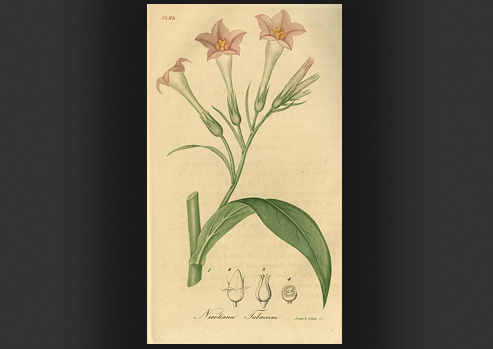
Pick Your Poison: Intoxicating Pleasures & Medical Prescriptions is an Exhibit from the U.S. National Library of Medicine. The Charles R. Drew Health Sciences Library hosted the exhibit from September 23 - October 31, 2015. The exhibit was on display for all faculty, staff, students, and people in our community. This exhibit is a transformation of a particular drug, from an acceptable indulgence to a bad habit, or vice versa, is closely tied to the intentions of those endorsing its use, and their status in society. This exhibition explores some of the factors that have shaped the changing definition of some of our most potent drugs, from medical miracle to social menace.

* All information and pictures are provided from NLM. For more in-depth look at this exhibit, please go to https://www.nlm.nih.gov/exhibition/pickyourpoison/

Mind-altering drugs have been used throughout the history of America. While some remain socially acceptable, others are outlawed because of their toxic, and intoxicating, characteristics. These classifications have shifted at different times in history, and will continue to change.

For generations, Native Americans have smoked pipes full of dried tobacco leaves for spiritual and social purposes and used the plant in medicinal remedies. Tobacco became known among English settlers as “God’s remedy” for its many uses. Smoking has endured as a popular pastime despite early evidence of tobacco’s dangerous effects. Regular users were labeled “slaves” to their habit. This reflects not just the addictive properties of the tobacco alkaloid, nicotine, but the great success of advertising, which helped to foster the habit among women as well as men, rich and poor, at work and at play.

Illustration of Nicotiana Tabacum from Jacob Bigelow, American Medical Botany, 1817. Courtesy National Library of Medicine

In the late 19th century, physicians recommended cocaine for the treatment of hay fever, asthma, and melancholy, and as a cure for alcoholism and opiate addiction. At this time, the typical cocaine user was a professional man who had been prescribed the drug or a physician administering his own doses. Widespread use of the drug soon demonstrated the addictive potential of the substance. Nevertheless, cocaine’s low cost made it popular among poorer groups and young people in saloons and dance halls. This association with thrill-seekers and poor laborers fuelled successive waves of panic about the drug during the 20th century.

BOTANICAL, Erythroxylon coca - In 1860, the alkaloid cocaine was isolated from coca leaves. English pharmacist William Martindale published his study on coca in response to contemporary medical interest in the use of cocaine. He noted the history of the use of coca leaves among South American Indians who chewed the leaves to stave off hunger and exhaustion.

In colonial America, home-brewed beer was popular among farmers and the working class and came to accompany a wide range of special events. Many physicians were enthusiastic about the medicinal properties of alcohol. As critics began to note the deleterious effects of frequent indulgence, reformers lobbied for tighter restrictions on the sale and purchase of alcoholic beverages. When prohibition outlawed alcohol manufacture and consumption, physicians retained the right to administer it by medical prescription.

Vitus vinifera from William Woodville, Medical botany: containing systematic and general descriptions, 1832. Courtesy National Library of Medicine

In the 19th century, cannabis was available in patent medicines sold at pharmacies or via prescription. Recreational users began by smoking the resin from the plant until the 1920s when Mexican immigrants introduced the technique of smoking the leaves. This association of the drug with unpopular groups of users undermined its legitimacy as a medical resource for decades. By the 1970s, cannabis became a controlled substance and physicians who prescribed the drug were in danger of losing their licenses whilst their patients risked criminal prosecution. After years of lobbying, some states now allow limited use for treatment of medical conditions.

BOTANICAL, Cannibis - American physician and botanist Charles Millspaugh noted the global history and preparation and use of cannabis in his classic work on American medicinal plants.

The pain-relieving properties of opium had been known for centuries when the drug was first used in America for the treatment of sleeplessness and illnesses such as coughs, smallpox, cholera, malaria, syphilis, dysentery, and tuberculosis. By the 19th century, many doctors believed so fervently in the benefits of opium use that that they personally indulged in the habit. The enthusiasm for medical treatments created many addicts among doctors and their patients, yet reformers’ efforts to restrict opium use focused on Chinese immigrants and the practice of opium smoking that they had introduced to America.

BOTANICAL, Papaver somniferum - As pharmacology professor Dr. Dennis Jackson noted in his guide to medicinal drugs, the pain-relieving properties of opium had been known for centuries. In America, the drug was first used for the treatment of sleeplessness and illnesses such as coughs, smallpox, cholera, malaria, syphilis, dysentery, and tuberculosis.
The CDU library host a special Conference Nicotine: Vice or Virtue on November 4, 2015. The special speaker was Theodore C. Friedman, M.D., Ph. D. Professor of Medicine (Charles R. Drew University, Professor of Medicine - UCLA. Chairman, Department of Internal Medicine. Chief, Division of Endocrinology, Molecular Medicine and Metabolism). This conference was around the exhibition. Here are some pictures of the conference:




